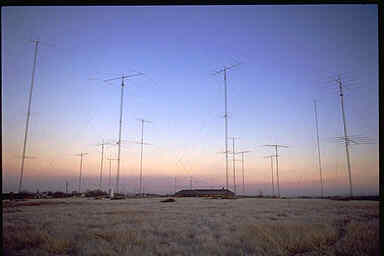
by George Fremin III - K5TR (ex.WB5VZL)

10 meters
The main 10 meter antenna was a single 6 element Telrex on a 36 foot boom at 120 feet. This antenna worked very well for the low angle times on the band. This tower also supported the South American stack - a pair of 4 element Cushcraft yagis at 75 feet over 40 feet. This also shows one of the design "features" of the N5AU station was fixed antennas - as they did not
involve rotators that can break and it is much faster to switch to an antenna then it is to wait for a beam to turn. It was very important that these fixed antennas work at least as well as the big yagis so that it was never necessary to turn one of the big antennas to work a station.
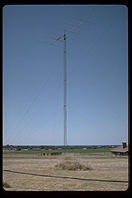
We also two other rotary antennas on 10 meters one was a 6 element Telrex at 80 feet. This antenna was used for the multiplier station during M/M efforts. The other rotary antenna on 10 meters as a 5 element Telrex at 50 feet (not pictured).
 The European antenna was a pair of Cushcraft yagis at 80 feet over 50 feet - this antenna also worked quite well for E-skip into the northeastern U.S. We also had a 5 element Telrex 10 meter yagi at 50 feet that was on a rotator.
The European antenna was a pair of Cushcraft yagis at 80 feet over 50 feet - this antenna also worked quite well for E-skip into the northeastern U.S. We also had a 5 element Telrex 10 meter yagi at 50 feet that was on a rotator.
15 meters
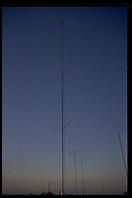
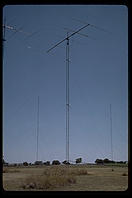 15 meters was Gordon's favorite band and it showed in the number of antennas. The big tall rotary antenna (left) was a 5 element Telrex yagi at 175 feet. This antenna was fantastic on long path and for working stations over the north pole. This tower also supported a pair of 4 element Cushcraft yaigs at 90 feet over 45 feet fixed on South America as well as a 4 element Cushcraft yagi at 120 feet (not on the the tower in this photograph) fixed on the South Pacific.
15 meters was Gordon's favorite band and it showed in the number of antennas. The big tall rotary antenna (left) was a 5 element Telrex yagi at 175 feet. This antenna was fantastic on long path and for working stations over the north pole. This tower also supported a pair of 4 element Cushcraft yaigs at 90 feet over 45 feet fixed on South America as well as a 4 element Cushcraft yagi at 120 feet (not on the the tower in this photograph) fixed on the South Pacific.
The other rotary antenna (right) for 15 meters was a 5 element Telrex yagi at 60 feet. This antenna was used for the second station during the multi-multis and was by far the best antenna for Africa in the afternoon.
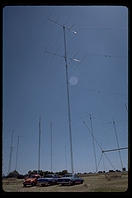 The European antenna was a pair of 5 element Telrex yagis at 135 feet over 90 feet. These antennas were feed in phase all the time and worked very well. There were times when we would be running Europe that other locals could not even hear. When we first put up a vertical stack fixed on Europe we put up three of these antennas. They were at 135'/90'/45' after using them for a few contests we decided that the upper pair was usually the best antenna and was never worse than the lower pair. We could only run two antennas at a time. The yagi that was the 45 foot high one in the stack was put at 175'.
The European antenna was a pair of 5 element Telrex yagis at 135 feet over 90 feet. These antennas were feed in phase all the time and worked very well. There were times when we would be running Europe that other locals could not even hear. When we first put up a vertical stack fixed on Europe we put up three of these antennas. They were at 135'/90'/45' after using them for a few contests we decided that the upper pair was usually the best antenna and was never worse than the lower pair. We could only run two antennas at a time. The yagi that was the 45 foot high one in the stack was put at 175'.
 The JA antenna was a pair of 5 element Telrex yagis side by side on two towers 70 feet high and 70 feet apart. From Texas Japan is a very important source of QSOs during a DX contest and this antenna was one of the better antennas on any band at the station. It had a very narrow beam width and was the best antenna for JA anytime the band was open - the only time the high antenna was better was for about 5 minutes at the beginning and end of the opening.
The JA antenna was a pair of 5 element Telrex yagis side by side on two towers 70 feet high and 70 feet apart. From Texas Japan is a very important source of QSOs during a DX contest and this antenna was one of the better antennas on any band at the station. It had a very narrow beam width and was the best antenna for JA anytime the band was open - the only time the high antenna was better was for about 5 minutes at the beginning and end of the opening.
20 meters
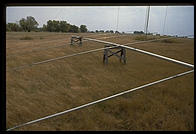 The big, tall antenna on 20 meters was a 5 element Telrex 46' boom yagi at 200 feet. (pictured on the ground)
This was dubbed the "Siberian Express" - it was the best antenna
over the pole. It also was by far the best antenna on the long path.
This antenna was also often the BEST antenna for the west during
sweepstakes - and I would often switch between it and the 100'
high antenna as the west choice on the switch during Sweepstakes.
This was one of the last additions made to the N5AU station. This 200 foot tower
also supported a pair of Hy-Gain 204BA yagis at 140 feet over 70 feet fixed on Europe.
It was only an ok performer, often the 100' high 5 element
was a better antenna for Europe.
The big, tall antenna on 20 meters was a 5 element Telrex 46' boom yagi at 200 feet. (pictured on the ground)
This was dubbed the "Siberian Express" - it was the best antenna
over the pole. It also was by far the best antenna on the long path.
This antenna was also often the BEST antenna for the west during
sweepstakes - and I would often switch between it and the 100'
high antenna as the west choice on the switch during Sweepstakes.
This was one of the last additions made to the N5AU station. This 200 foot tower
also supported a pair of Hy-Gain 204BA yagis at 140 feet over 70 feet fixed on Europe.
It was only an ok performer, often the 100' high 5 element
was a better antenna for Europe.
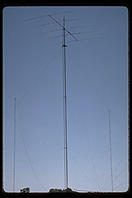 The main general purpose antenna for 20 meters was a 5 element Telrex 46' boom yagi at 100 feet.
This antenna was put up when the station was built in 1980 and was a great antenna.
It worked great for DX and was usually used as the WEST antenna
during the sweepstakes contests. Until we put up the 200 footer this was the
highest 20 meter antenna. This tower also supported a homebrew 4 element yagi at
50 feet fixed on South America. (not pictured)
The main general purpose antenna for 20 meters was a 5 element Telrex 46' boom yagi at 100 feet.
This antenna was put up when the station was built in 1980 and was a great antenna.
It worked great for DX and was usually used as the WEST antenna
during the sweepstakes contests. Until we put up the 200 footer this was the
highest 20 meter antenna. This tower also supported a homebrew 4 element yagi at
50 feet fixed on South America. (not pictured)
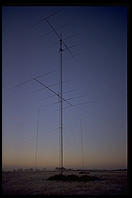 We added a lower antenna at 50' fixed on Europe. This was a great European
antenna but after sidemount broke, leaving the antenna hanging by the feedline
and resting on a guy wire we never put it back up. This antenna later became the
200 foot high yagi. This stack was up in 1986 when we won the CQ WW SSB contest.
We added a lower antenna at 50' fixed on Europe. This was a great European
antenna but after sidemount broke, leaving the antenna hanging by the feedline
and resting on a guy wire we never put it back up. This antenna later became the
200 foot high yagi. This stack was up in 1986 when we won the CQ WW SSB contest.
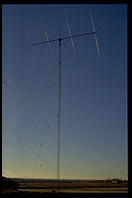 4 element QUAD on a 36' boom at 80'
This was a great antenna. During the day it was sometimes a better
antenna for europe than the 100' 5 element. It was always the
best antenna for working the United States. We used this antenna as the northeast
antenna in the Sweepstakes.
4 element QUAD on a 36' boom at 80'
This was a great antenna. During the day it was sometimes a better
antenna for europe than the 100' 5 element. It was always the
best antenna for working the United States. We used this antenna as the northeast
antenna in the Sweepstakes.
Hygain 204BA at 70'
Good antenna - it did not have the gain of the bigger antennas
but it was used mainly as a fill antenna.
It was also sometime used as the "west" antenna in the sweepstakes.
40 Meters

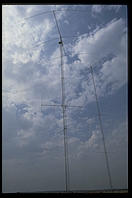 40 meters was a band that we did very well on from N5AU but in contrast to the higher bands
it has few antennas. The Primary antenna for 40 meters was a 3 element Telrex yagi on a 48 foot
boom at 120 feet. This antenna was put up in 1980 when the station and never needed any
repairs. The Tower was Rohn 45G and was double guyed at the top guy point. The rotator
was a big Telrex and always turned this antenna with ease. Here are two diffrent views of this
antenna. In the photo to the right you can see a 4 element 20 meter yagi that is fixed
towards South America.
40 meters was a band that we did very well on from N5AU but in contrast to the higher bands
it has few antennas. The Primary antenna for 40 meters was a 3 element Telrex yagi on a 48 foot
boom at 120 feet. This antenna was put up in 1980 when the station and never needed any
repairs. The Tower was Rohn 45G and was double guyed at the top guy point. The rotator
was a big Telrex and always turned this antenna with ease. Here are two diffrent views of this
antenna. In the photo to the right you can see a 4 element 20 meter yagi that is fixed
towards South America.
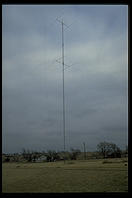 The other 40 meter antenna was a stack of 2 element Cushcraft yagis at 190 feet over 120 feet. The
top antenna rotates and the lower one was fixed on Japan with upper / lower / both switching.
We found that two of the Cushcrafts would just about equal the 3 ele fullsixed yagi. This tower also
supported the three 160 meter sloping dioples. You can see one of the dipole feedlines in this
photograph.
The other 40 meter antenna was a stack of 2 element Cushcraft yagis at 190 feet over 120 feet. The
top antenna rotates and the lower one was fixed on Japan with upper / lower / both switching.
We found that two of the Cushcrafts would just about equal the 3 ele fullsixed yagi. This tower also
supported the three 160 meter sloping dioples. You can see one of the dipole feedlines in this
photograph.
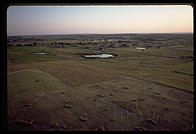 If you have ever wanted to know what it was like to look down on 100 plus foot towers, here is a
veiw from the top of this 190 foot tower. In this photograph you are looking to the southwest
and the 3 element fullsized 40 meter yagi is in the middle of the photograph. It is kind of hard
to see as it has the pond behind it.
If you have ever wanted to know what it was like to look down on 100 plus foot towers, here is a
veiw from the top of this 190 foot tower. In this photograph you are looking to the southwest
and the 3 element fullsized 40 meter yagi is in the middle of the photograph. It is kind of hard
to see as it has the pond behind it.
80 Meters
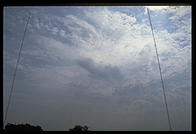 The 80 meter antennas were mainly made of wire and wire is very hard to photograph.
The biggest of the 80 meter antennas was a 3 element delat loop on a 100 foot boom.
It was suspended between two 170 foot towers. The tops of the loops were at about
160 feet and the bottoms were around 90 feet. It was pointed at Europe and was always
at least 10db better than a diople at the same height. It was also a very quiet antenna.
You can just barely make out some of the loops in this photograph.
The 80 meter antennas were mainly made of wire and wire is very hard to photograph.
The biggest of the 80 meter antennas was a 3 element delat loop on a 100 foot boom.
It was suspended between two 170 foot towers. The tops of the loops were at about
160 feet and the bottoms were around 90 feet. It was pointed at Europe and was always
at least 10db better than a diople at the same height. It was also a very quiet antenna.
You can just barely make out some of the loops in this photograph.
Other 80 meter antennas were a diople at 180 feet broadside east/west, A diople at about
130 feet broadside norhteast/southwest, A dipole at 140 feet broadside north/south and a
bobtail curtian broadside northwest/southeast.
160 Meters
 The 160 meter antennas have the same problem as on 80 meters, wires just don't make good photographic
subjects. On 160 meters we had 3 half-wave slopping dipoles on the 190 foot tower. The guy wires
were not broken up and the dipoles bisected the guy angles. We had antennas northeast, southeast and
west. This antenna worked very well and I think it was the single most impressive antenna on ANY band
at the station. If you would like to hear how it sounded you can listen to a recording I made when I was at HR6A.
The 160 meter antennas have the same problem as on 80 meters, wires just don't make good photographic
subjects. On 160 meters we had 3 half-wave slopping dipoles on the 190 foot tower. The guy wires
were not broken up and the dipoles bisected the guy angles. We had antennas northeast, southeast and
west. This antenna worked very well and I think it was the single most impressive antenna on ANY band
at the station. If you would like to hear how it sounded you can listen to a recording I made when I was at HR6A.
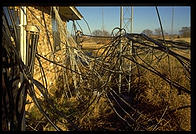 Having all of these antennas means that you need alot of hardline and control/rotator cables.
All of the antennas were feed with either 1/2 inch or 7/8 inch hardline. Some of the feeline runs
were in the 400 to 600 foot range. Even though this looks like a real mess I got to the point
that I knew what and where most of it was.
Having all of these antennas means that you need alot of hardline and control/rotator cables.
All of the antennas were feed with either 1/2 inch or 7/8 inch hardline. Some of the feeline runs
were in the 400 to 600 foot range. Even though this looks like a real mess I got to the point
that I knew what and where most of it was.
Go inside and take a look around.
Take a look around from the top of the 190 foot tower.
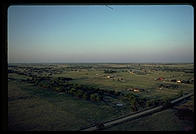 BIG
BIG
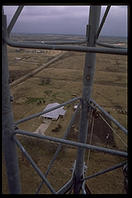 BIG
BIG
 BIG
BIG